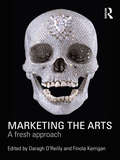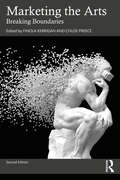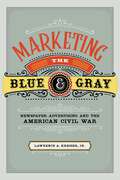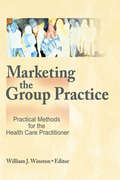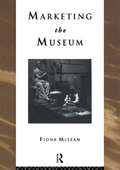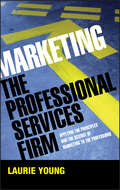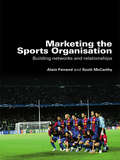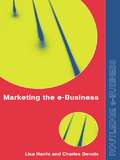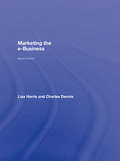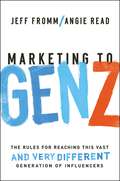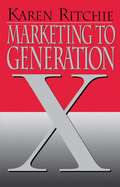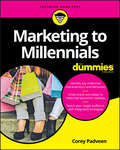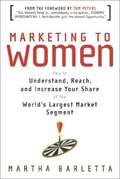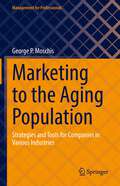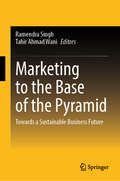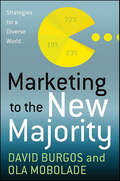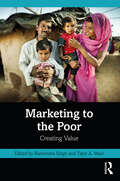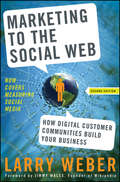- Table View
- List View
Marketing the Arts: A Fresh Approach
by Daragh O'Reilly Finola KerriganIn recent years, there have been significant shifts in arts marketing, both as a practice and an academic discipline. The relationship between art and the market is increasingly complex and dynamic, requiring a transformation in the way the arts are marketed. Marketing the Arts argues that arts marketing is not about the simple application of mainstream managerial marketing to the arts. With contributions from international scholars of marketing and consumer studies, this book engages directly with a range of contemporary themes, including: The importance of arts consumption and its social dimensions The importance of the aesthetic experience itself, and how to research it Arts policy development The art versus commerce debate The role of the arts marketer as market-maker The artist as brand or entrepreneur This exciting new book covers topics as diverse as Damien Hirst’s 'For the Love of God', Liverpool’s brand makeover, Manga scanlation, Gob Squad, Surrealism, Bluegrass music, Miles Davis and Andy Warhol, and is sure to enthuse students and enlighten practitioners.
Marketing the Arts: Breaking Boundaries
by Finola Kerrigan Chloe PreeceWith contributions from international scholars of marketing and consumer studies, this renowned text engages directly with a range of contemporary themes, including: The importance of arts consumption and its socio-cultural, political, and economic dimensions The impact of new technologies, platforms, and alternative artforms on the art market The importance of the aesthetic experience itself and how to research it The value of arts-based methods The art versus commerce debate The artist as entrepreneur The role of the arts marketer as market-maker This fully updated new edition covers digital trends in the arts and emerging technologies, including virtual reality, streaming services, and branded entertainment. It also broadens the scope of investigation beyond the West looking to film in emerging markets such as China, music in Sub-Saharan Africa, and indigenous art in Australia. Alongside in-depth theoretical analysis, this edition of Marketing the Arts takes inspiration from the creativity inherent in current artistic practice to demonstrate a plurality of approaches and methodologies. Marketing the Arts: Breaking Boundaries is core reading for advanced undergraduate and postgraduate students studying arts marketing and management. Online resources include chapter-by-chapter PowerPoint slides and questions for class discussion.
Marketing the Blue and Gray: Newspaper Advertising and the American Civil War
by Lawrence A. Kreiser Jr.Lawrence A. Kreiser, Jr.’s Marketing the Blue and Gray analyzes newspaper advertising during the American Civil War. Newspapers circulated widely between 1861 and 1865, and merchants took full advantage of this readership. They marketed everything from war bonds to biographies of military and political leaders; from patent medicines that promised to cure almost any battlefield wound to “secession cloaks” and “Fort Sumter” cockades. Union and Confederate advertisers pitched shopping as its own form of patriotism, one of the more enduring legacies of the nation’s largest and bloodiest war. However, unlike important-sounding headlines and editorials, advertisements have received only passing notice from historians. As the first full-length analysis of Union and Confederate newspaper advertising, Kreiser’s study sheds light on this often overlooked aspect of Civil War media. Kreiser argues that the marketing strategies of the time show how commercialization and patriotism became increasingly intertwined as Union and Confederate war aims evolved. Yankees and Rebels believed that buying decisions were an important expression of their civic pride, from “Union forever” groceries to “States Rights” sewing machines. He suggests that the notices helped to expand American democracy by allowing their diverse readership to participate in almost every aspect of the Civil War. As potential customers, free blacks and white women perused announcements for war-themed biographies, images, and other material wares that helped to define the meaning of the fighting. Advertisements also helped readers to become more savvy consumers and, ultimately, citizens, by offering them choices. White men and, in the Union after 1863, black men might volunteer for military service after reading a recruitment notice; or they might instead respond to the kind of notice for “draft insurance” that flooded newspapers after the Union and Confederate governments resorted to conscription to help fill the ranks. Marketing the Blue and Gray demonstrates how, through their sometimes-messy choices, advertising pages offered readers the opportunity to participate—or not—in the war effort.
Marketing the Group Practice: Practical Methods for the Health Care Practitioner
by William WinstonA practical guide for providers and administrators in the health industry, this stimulating volume explains how to effectively use a variety of marketing practices such as advertising, public relations, fund raising, and “word of mouth” from satisfied clients.
Marketing the Museum
by Fiona McleanMarketing the Museum is the ideal guide to the ways in which museums can overcome the numerous hurdles on the route to truly achieving a marketing orientation. The history of the museum is one of shifting purposes and changing ideals and this volume asks if it is possible to define the 'product' which the modern museum can offer. This book explores the crucial question: Are the theories of marketing developed for manufactured goods in any way relevant to the experience of visiting a museum? In covering one of the most highly disputed issues in the field, this book is essential reading for museum professionals, students and anyone who has dealing in the many branches of the heritage industry around the world.
Marketing the National Hockey League
by V. Kasturi Rangan Marie BellOne third of the 24 National Hockey League (NHL) teams are unprofitable. Another third are barely profitable. This case provides the background and market research data to help the senior managers of the NHL make decisions pertaining to how they would like to grow the fan base. The two choices under consideration are network advertising and grassroots marketing.
Marketing the Professional Services Firm
by Laurie YoungProfessional services are estimated to be worth up to $700 billion worldwide, but as the market matures there is an urgent need for new marketing thinking for global players or small businesses alike. This book applies the core principles of strategic marketing to professional services for the first time, in an approach that is at once accessible and compelling. With case studies from a range of companies including J. Walter Thompson, market research companies, the ?big four? accounting firms, Headhunters, Interbrand and large US legal firms, it is intended to become the definitive book for effective strategic marketing in professional services.
Marketing the Public Sector: Promoting the Causes of Public and Nonprofit Agencies
by Seymour H. FineThe administrative officers of public and nonprofit organizations have become increasingly interested in marketing techniques during the 1990s. They reason that if commercial marketing methods can successfully move merchandise across the retail counter, those same techniques should be capable of creating a demand for such "social products" as energy conservation, women's rights, military enlistment, or day-care centers. The goal of this volume is to provide social sector executives with practical and effective guidelines on how to harness the power of marketing in order to improve service to their constituencies.Marketing the Public Sector builds upon two decades of research in social marketing and represents the current state of the art. The authors demonstrate how the principles developed in earlier studies can be applied in actual situations. Included here are case studies of marketing plans prepared for hospitals, political campaigns, Third World social change, and community foundations that proved to be as effective as those in the private sector.The case study approach is effectively supplemented by theoretical chapters that define first principles in essential matters such as product management, value determination, advertising, and analysis of market performance. This amalgamation of theory and application is suitable to middle-range social marketing sizes as well as full-scale projects that large agencies might undertake. The problems differ only in magnitude; no organization is too small or too large to adopt a consumer orientation. Marketing the Public Sector is not only a guide to marketing; it is also about communication, social change, propaganda, and education. It will be of great interest to sociologists; public sector administrators; and specialists in communications, public relations, fund-raising, and community affairs.
Marketing the Sports Organisation: Building Networks and Relationships
by Alain Ferrand Scott McCarthyMarketing and the world of sport overlap in two main ways: in the marketing of sports related products and services, and in the use of sports events to market a broader range of products and services. Marketing the Sports Organisation introduces the most effective marketing methods and tools available to sports organizations, and offers practical,
Marketing the Water-Energy-Food (WEF) Nexus: Testing Message Effects with American College Students
by Q.J. YaoThis book helps readers understand the persuasiveness of popular message levels (agenda, knowledge, attitude, and behavioral intention) and factors (sidedness, conclusiveness, and gain- or loss-framing) in communicating critical environmental issues, particularly the Water-Energy-Food (WEF) Nexus. The WEF Nexus is a relatively new environmental concept that has been deemed by leading scientists and international organizations as an effective solution to water, energy, and food shortages and crises. It is vital to garner sufficient public support for the concept to function. This book addresses questions such as: How can we strategically and effectively communicate the WEF Nexus to the public to raise necessary public awareness and supportive attitudes, avoid unnecessary politicization, and secure public resources to cope with the water, energy, and food issues before they drastically deteriorate? How can some commonly used message factors affect the persuasiveness of the WEF-nexus strategic communications, and how may those communications be processed by the audience? These questions are answered with data from the National College Student Science Literacy Survey (NCSSLS), a relatively representative survey of American college students in 2016-2018, with a survey experiment included in its second round.
Marketing the Wilderness: Outdoor Recreation, Indigenous Activism, and the Battle over Public Lands
by Joseph WhitsonHow outdoor industry marketing promotes an image of &“the wilderness&” as an unpeopled havenMarketing the Wilderness analyzes the relationship between the outdoor recreation industry, public lands in the United States, and Indigenous sovereignty and representation in recreational spaces. Combining social media analysis, digital ethnography, and historical research, Joseph Whitson offers nuanced insights into more than a century of the outdoor recreation industry&’s marketing strategies, unraveling its complicity in settler colonialism. Complicating the narrative of outdoor recreation as a universal good, Whitson introduces the concept of &“wildernessing&” to describe the physical, legal, and rhetorical production of pristine, empty lands that undergirds the outdoor recreation industry, a process that further disenfranchises Indigenous people from whom these lands were stolen. He demonstrates how companies such as Patagonia and REI align with the mining and drilling industries in their need to remove Indigenous peoples and histories from valuable lands. And he describes the ways Indigenous and decolonial activists are subverting and resisting corporate marketing strategies to introduce new narratives of place. Through the lens of environmental justice activism, Marketing the Wilderness reconsiders the ethics of recreational land use, advocating for engagement with issues of cultural representation and appropriation informed by Indigenous perspectives. As he discusses contemporary public land advocacy around places such as Bears Ears National Monument, Whitson focuses on the deeply fraught relationship between the outdoor recreation industry and Indigenous communities. Emphasizing the power of the corporate system and its treatment of land as a commodity under capitalism, he shows how these tensions shape the American idea of &“wilderness&” and what it means to fight for its preservation. Retail e-book files for this title are screen-reader friendly with images accompanied by short alt text and/or extended descriptions.
Marketing the e-Business
by Lisa Harris Charles DennisSince the much-hyped dot.com crash, treading the e-business path can be daunting. In these increasingly uncertain and cynical times, this useful text unpicks the challenges of e-Marketing for many types of business. It uses topical case studies and accompanying web material to provide an up-to-date study of effective marketing strategies. Topics include: *Multi-channel marketing strategies*Change Management*Lessons learned from the dot.com crash*Branding, e-Retail and relationship building*Digital divides, privacy and data security. Providing a new approach to the subject matter, this book analyses the benefits of e-Marketing as a tool for improving efficiency and effectiveness rather than business revolution. Considering the practicalities of marketing in an e-Business context, it is the first book of its kind to voice such a rigorous argument for the importance of e-Marketing, and a crucial text for anyone studying or practicing e-Business.
Marketing the e-Business
by Lisa Harris Charles DennisE-marketing is rapidly growing in significance and is having a direct impact upon traditional marketing strategy and operations. It requires planning and innovation to make it work, implying organisational commitment and effective management, supported by appropriate technology, process and structure.Fully updated to reflect the latest developments
Marketing to Gen Z: The Rules for Reaching This Vast--and Very Different--Generation of Influencers
by Jeff Fromm Angie ReadWith bigger challenges come great opportunities, and Marketing to Gen Z wants to help you get ahead of the game when it comes to understanding and reaching this next generation of buyers.Having internalized the lessons of the Great Recession, Generation Z blends the pragmatism and work ethic of older generations with the high ideals and digital prowess of youth. For brands, reaching this mobile-first and socially conscious cohort requires real change, not just tweaks to the Millennial plan.In Marketing to Gen Z, businesses will learn how to:Get past the 8-second filterAvoid blatant advertising and tap influencer marketingUnderstand their language and off-beat humorOffer the shopping experiences they expectMarketing to Gen Z dives into and explains all this and much more, so that businesses may most effectively connect and converse with the emerging generation that is expected to comprise 40 percent of all consumers by 2020.Now is the time to learn who they are and what they want!
Marketing to Generation X
by Karen RitchieAs so-called baby boomers age, there has arisen a new generation to be categorized, characterized, analyzed, stereotyped, written about, targeted, and advertised and sold to. And apparently none of this can happen without first tagging it with a label. The name that seems to have stuck so far is "Generation X," taken from Douglas Coupland's 1991 novel. If nothing else, though, that label suggests an unknown quantity and emphasizes the fact that the most recent generation to come of age is more diverse and fragmented than any before. Undaunted, Ritchie, a past senior vice-president at advertising powerhouse McCann-Erickson and now responsible for media buying for General Motors, argues that marketers and advertisers have ignored differences between "X-er's" and "boomers," which they must now face up to or risk losing this newly dominant market. Traits belonging to this group worth noting, suggests Ritchie, are its diversity, fascination with interactivity, resistance to obvious or patronizing marketing appeals, uncertain future, and general resentfulness of the attention the previous generation received.
Marketing to Millennials For Dummies
by Corey PadveenMarket effectively to the millennial mindset Millennials make up the largest and most valuable market of consumers in the United States —but until you understand how to successfully market to them, you may as well kiss their colossal spending power away! Packed with powerful data, research, and case studies across a variety of industries, Marketing to Millennials For Dummies gives you a fail-proof road map for winning over this coveted crowd. Millennials are projected to have $200 billion buying power by 2017, and $10 trillion over their lifetimes — and yet industries across the board are struggling to garner their attention. Revealing what makes this darling demographic tick, this hands-on guide shows you how to adapt to new media, understand the 'sharing economy,' and build meaningful relationships that will keep your brand, product, or service at the forefront of the millennial mind. Identify key millennial characteristics and behaviors Grasp and adapt to millennial economic realities Reach your target audience with integrated strategies Build deep, lasting connections with millennials Get ready to crack the code —millennials are a mystery no more!
Marketing to Millennials: Reach the Largest and Most Influential Generation of Consumers Ever
by Christie Garton Jeff FrommThe numbers cannot be ignored: eighty million Millennials wielding $200 billion in buying power are entering their peak earning and spending years. Companies that think winning their business is a simple matter of creating a Twitter account and applying outdated notions of "cool" to their advertising are due for a rude awakening. Marketing to Millennials is both an enlightening look at this generation of consumers and a practical plan for earning their trust and loyalty. Based on original market research, the book reveals the eight attitudes shared by most Millennials, as well as the new rules for engaging them successfully. Millennials: * Value social networking and aren't shy about sharing opinions * Refuse to remain passive consumers--they expect to participate in product development and marketing * Demand authenticity and transparency * Are highly influential--swaying parents and peers * Are not all alike--understanding key segments is invaluable Featuring expert interviews and profiles of brands doing Millennial marketing right, this eye-opening book is the key to persuading the customers who will determine the bottom line for decades to come.
Marketing to Women: How to Understand, Reach, and Increase Your Share of the Largest Market Segment
by Martha BarlettaBarletta presents a compelling business case for why marketing professionals should allocate real dollars and undivided attention to the largest untapped market in the world--women. She then explains why and how women reach different brand purchase decisions.
Marketing to the Affluent
by Dr. Thomas J. StanleyThe New York Times bestselling author of The Millionaire Next Door shares proven strategies and expert advice on successfully entering the affluent market. No one knows the rich like the author and business theorist Thomas Stanley. In this book, Stanley explains what it takes to reach, persuade, and market to this highly targeted audience. Stanley discusses the unique perspectives of wealthy individuals, revealing the needs and desires any marketing campaign needs to address in order to be successful with them. Stanley then outlines several highly effective ways to meet those needs, including how to attract wealthy customers through word-of-mouth recommendations from their friends, family, and business associates. Marketing to the Affluent covers: Myths and realities about the affluentUnderstanding what the affluent wantFinding &“overlooked&” millionairesPositioning yourself as an expert &“No one better illuminates the who, where, and how of the affluent market than Tom Stanley.&”—J. Arthur Urciuoli, Director of Marketing, Merrill Lynch
Marketing to the Ageing Consumer
by Dick Stroud Kim WalkerUnderstand the impact of a global ageing population on how products are bought, and the effect this has on how to market and advertise these products and services to the older generation of consumers. Contains models for companies to evaluate the success of their own strategies, with tools for improving their age-friendly marketing campaigns.
Marketing to the Aging Population: Strategies and Tools for Companies in Various Industries (Management for Professionals)
by George P. MoschisThis book coaches marketing practitioners and students how to best satisfy the needs of the older consumer population. It first highlights the heterogeneity of the older consumer market, then examines the specific needs of the older consumer. Lastly, the book highlights the most effective ways of reaching and serving older consumer segments for different products and services such as financial services, food and beverages, healthcare and pharmaceuticals, and travel among others. It presents segment-to-industry specific strategies that help marketers develop more refined and targeted micro-marketing strategies and customer relationship management (CRM) systems for building and retaining a large base of older customers. These strategies also help demonstrate how companies can make decisions that increase profitability not only by satisfying consumer needs and wants, but also by creating positive change and improvement in consumer well-being.
Marketing to the Base of the Pyramid: Towards a Sustainable Business Future
by Ramendra Singh Tahir Ahmad WaniThis book is a collection of nine chapters discussing the impact of sustainable marketing and business practices on the stakeholders at the base of the pyramid (BoP). It explores multifaceted dimensions related to sustainable practices such as sustainable consumer behavior, marketplace literacy for low-income and low-literate consumers, innovation and BoP and emerging markets, bridging vulnerability and sustainability, inclusive marketing practices, and how to bridge the economic, social and environmental aspects of sustainability. These chapters have been authored by the best marketing scholars working in the domain of marketing at the base of the pyramid, including scholars who actively promote bottoms up approach to enhance well-being and prosperity of subsistence marketplaces. Primarily aimed at marketing scholars, another important objective of this edited book is to reach out to organizations looking for deeper insights on how they can successfully position their products and services to poor consumers, or even how they can purchase/source products and services from poor producers. Professional associations such as ASSOCHAM, CII, FICCI, AIMA, AMA would also find many relevant takeaways in the book, as would academicians and policymakers of developing nations in Asia, Americas and Africa.
Marketing to the New Majority: Strategies for a Diverse World
by David Burgos Ola MoboladeToday, diversity is the default, not the exception. "Minorities" are already the majority in some of the biggest cities in the United States, and demographers predict that the same will be true of the country as a whole before 2050. Yet companies continue to address the "general market" as a separate audience from ethnic consumers, rather than acknowledging that the new mainstream is itself multicultural. In addition, many who do target multicultural audiences still employ ad strategies that rely heavily on stereotypes and fail to resonate with minority communities. Here, David Burgos and Ola Mobolade look at the changed marketplace revealed in the new 2010 Census data, and show marketers how to develop integrated campaigns that effectively reach these culturally diverse consumer populations. Drawing on interviews with industry leaders and Millward Brown's vast database of consumer research, this book will be a roadmap to the opportunities and challenges of marketing to the new mainstream in a way that feels natural, respectful, and inclusive.
Marketing to the Poor: Creating Value
by Ramendra Singh and Tahir A. WaniThis book looks at markets in low-income economies and how they require fundamentally different marketing systems and strategies. Analyzing the sociocultural characteristics of these markets, it offers solutions for businesses to overcome spatial, institutional, and financial challenges while working in these contexts. Markets for the poor are characterized by resource scarcity, weak institutions, and low literary rates, as well as a strong presence of cultural and community ties. This book provides an understanding of these marketplaces, including the consumer’s wants and aspirations, the relationship of the individual within the social milieu, and their unique cultural contexts. It provides strategies for businesses to develop a bottom-up knowledge of global markets and incorporates practices which are inclusive and sustainable. It also explores the links between human development, entrepreneurship, and marketing which are especially relevant in the pandemic-hit global economy. This book will be of interest to students and researchers of marketing, business studies, business administration, rural management, marketing management, economics, and development studies.
Marketing to the Social Web
by Larry WeberAn updated and expanded Second Edition of the popular guide to social media for the business communityMarketers must look to the Web for new ways of finding customers and communicating with them, rather than at them. From Facebook and YouTube to blogs and Twitter-ing, social media on the Internet is the most promising new way to reach customers. Marketing to the Social Web, Second Edition helps marketers and their companies understand how to engage customers, build customer communities, and maximize profits in a time of marketing confusion. Author and social media guru Larry Weber describes newly available tools and platforms, and shows you how to apply them to see immediate results and growth.Rather than broadcast messages to audiences, savvy marketers should encourage participation in social networks to which people want to belong, where dialogue with customers, and between customers, can flourish. in Networking sites like MySpace, Facebook, and even Flickr are the perfect forums for this dialog; this book shows you how to tap into this new media.In addition to the tools and tactics that made Marketing to the Social Web a critical hit among marketers, this second edition includes three entirely new chapters that cover recent changes in the field. These new chapters describe how Facebook will monetize its business and one day surpass Google; how companies can measure the influence and effectiveness of their social media campaigns; and how marketing to mobile social media will grow into an effective practice in the near future.Marketing must reach out into new forms, media, and models. Marketing to the Social Web, Second Edition presents an exceptional opportunity to use these new tools and models to reach new markets, even in today's fragmented media environment.Larry Weber has spent the last three decades building global communications companies, including Weber Shandwick Worldwide and the W2 Group. He is also the founder and Chairman of the Massachusetts Innovation and Technology Exchange, the nation's largest interactive advocate association.
